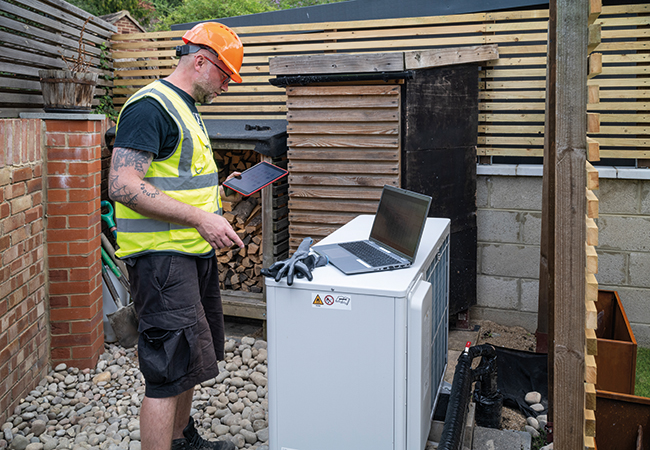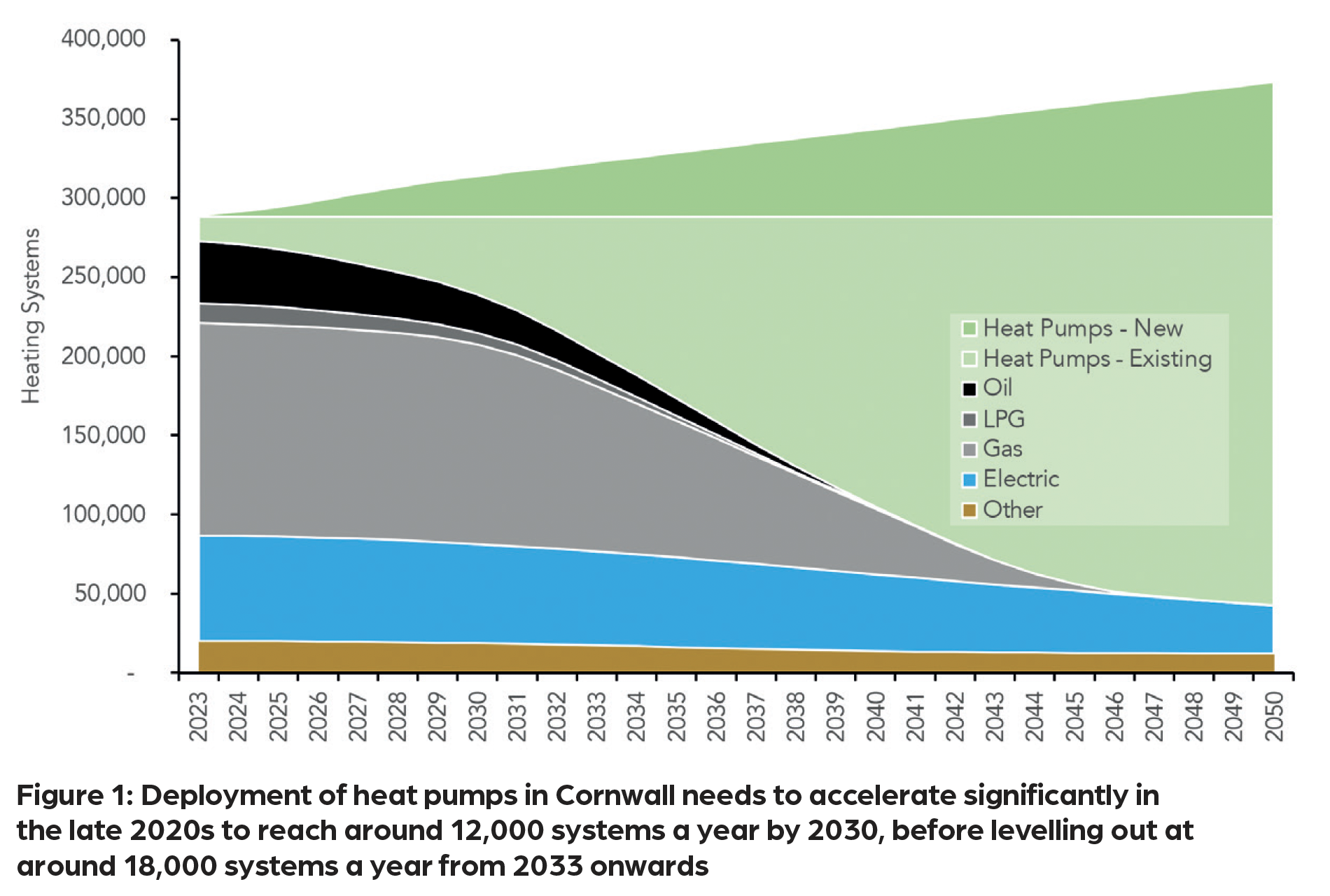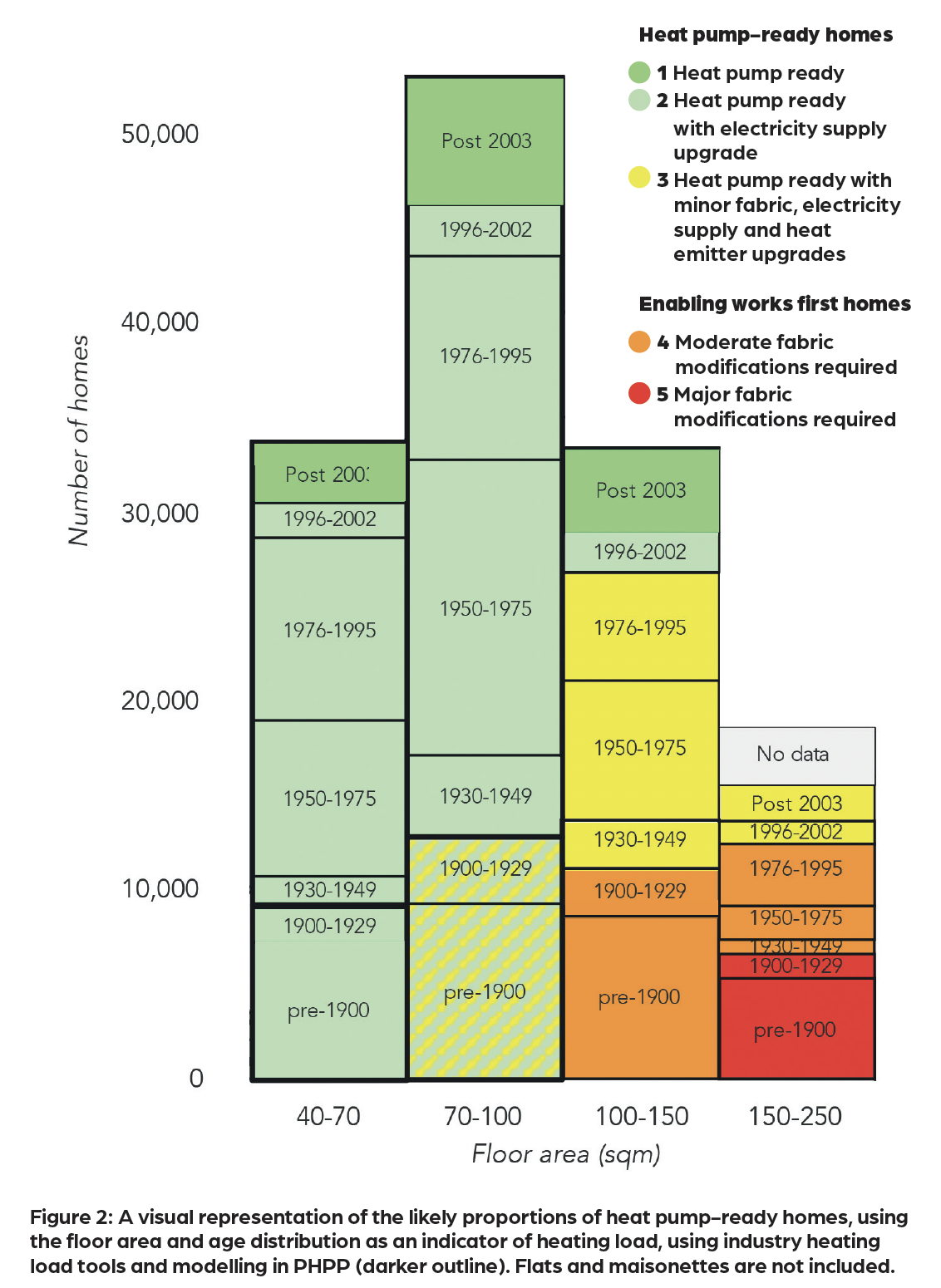
Having introduced a net zero energy requirement for new homes in 20211, Cornwall Council is now developing its strategic plans to end greenhouse gas emissions from existing homes. Etude, alongside Currie & Brown, provided the evidence for the 2021 targets and has been working with Cornwall on its follow-up retrofit strategy.
Although local authorities have generally adopted a ‘fabric first’ approach to their housing decarbonisation strategies, we felt there was a need for greater focus on the importance of rapidly decarbonising heat, and how to do this in an affordable way.
With this in mind, we recommend, as the first step, retrofitting a heat pump alongside basic fabric efficiency improvements, adequate ventilation, and photovoltaic panels. This delivers an immediate emission reduction of around 80% to 90%, while operational costs should be similar to, or much lower than, a fossil fuel boiler.
We recommend further fabric efficiency improvements over time, as parts of the building naturally need to be repaired or replaced, to eventually reach levels recommended by LETI.
This approach mirrors that of the Association for Environment Conscious Building’s (AECB’s) step-by-step retrofit programme, the Superhomes programme in Ireland, and the UK Passivhaus Trust in its recent paper The right time for heat pumps.
How much, how fast?
Required rates of heat pump deployment were modelled by applying the Climate Change Committee’s (CCC’s) Sixth Carbon Budget recommendations to Cornwall’s housing stock. These include an end to the replacement of off-gas grid boilers from 2028 and on-gas grid boilers from 2033. We did not apply the CCC’s assumption that 11% of homes will use hydrogen boilers, as we could not find evidence to support this approach.
We also reduced the proportion of district heating to account for the lower density of heat loads in Cornwall, compared with the national average. There could be a future role for geothermal heat via heat networks, if it turns out to be cheaper than individual heat pumps.
We also expect individual heat pumps connected to ambient temperature borehole arrays to play a role. The modelling indicated that, by 2030, 16% of existing fossil fuel heating systems will need to be replaced with heat pumps, increasing to 46% by 2035, and 77% by 2040.

Understanding heat pump readiness
A key question with a heat pump-led approach to retrofit was whether existing homes would be ‘heat pump ready’. A common misconception with heat pumps is that they won’t work efficiently, or at all, in poorly insulated homes.
The reality is that a heat pump is indifferent to its surroundings; it just moves heat from one place to another and will work as long as it, and the heat emitters, are large enough to meet the dwelling’s peak heat load at the design flow temperature.
For each retrofit, three levers can be applied to achieve heat pump readiness: reduce the peak heat demand through fabric efficiency; increase the heat emitter size; and increase flow temperatures. The optimum balance between them will be different for each home, depending on the desired split between upfront cost versus operating costs.
The main physical constraint facing most homes in Cornwall is their electrical supply capacity. This is determined by the electricity cable that runs from the street to the house, the electricity meter, and the main fuse. While a domestic single-phase supply can, in principle, supply a maximum of 24kW of electrical capacity, some distribution network operator (DNOs) only offer up to 19kW as standard, and older homes may have as little as 7kW. Upgrades are often paid for by the DNO, but can take some time to complete, which can be an issue in the case of emergency boiler replacements.
The largest single-phase heat pumps draw about 6-8kW of electricity under peak demand conditions, which corresponds to a heat output of around 14-18kW. This means that, even with a modern electrical supply, homes with a peak heat load of more than 16kW will need fabric retrofit work, a secondary heating system, and/or a three-phase supply.

Heat pump readiness in Cornwall’s housing stock
To predict the heat pump readiness of Cornwall’s housing stock, we used stochastic Passive House Planning Package (PHPP ) modelling – which accounts for variability and uncertainty – and calculated 5,000 versions of each building typology with a range of parameters that affect the peak heat load.
We adapted the PHPP calculation to adopt key elements of the MCS heat pump sizing methodology, such as the external and internal design temperatures, airtightness and ventilation assumptions. Parameters were varied for different levels of fabric performance, shading, orientation and form (detached, semi-detached or mid-terrace). This enabled us to predict heat pump readiness more effectively, by understanding best- and worst-case scenarios for typical building types. The results of the PHPP modelling indicated similar ranges of heat loss to industry heating load tools from organisations such as Panasonic and Heat Geek, for different age properties.
Combining this with Energy Performance Certificate data on floor area and age, we were able to determine that 70-80% of homes are expected to be heat pump ready. Some upgrades to the electricity supplies may be necessary, while upgrades to heat emitters and fabric may be desirable. (See Figure 2).

What about costs?
Ensuring good efficiency is the foundation of achieving low operational costs and is an effective approach for all homes. The Electrification of Heat Demonstration Project reported an average efficiency of 290% across around 740 homes with heat pumps. However, the best installers are routinely delivering efficiencies of 340% on their systems, while mature markets in Europe are doing even better.
Dynamic tariffs and solar
While efficiency is important, a heat pump’s superpower is that it can use dynamic electricity tariffs and solar. Unlike gas, wholesale electricity prices vary constantly throughout the day, as demand and the generation mix change.
Use of tariffs that take advantage of this can result in cost reductions of 45% compared with a gas boiler. The addition of solar generation further reduces costs and, where sufficient space is available, can completely eliminate energy bills on an annual basis.
With suitable financing, a large proportion of net zero retrofits can be cash positive for residents on a monthly basis, as reductions to energy bills exceed loan repayments.
What about Grid capacity? This comes up a lot when heat pumps are discussed, but our experience is that, in many cases, electric vehicle charging will draw far more electricity than heat pumps, which means that supply upgrades are often required anyway.
Cornwall’s DNO, National Grid Electricity Distribution, explained to us that it is actively planning for the rollout of heat pumps.
National Grid’s Distribution Future Energy Scenarios are regional versions of its national Future Energy Scenarios. Its two most ambitious heat pump deployment pathways align well with the pathway we calculated for Cornwall based on the CCC’s Sixth Carbon Budget, which provides reassurance that the Grid will be ready.
Building a workforce to decarbonise homes
We see training of adequate numbers of heat pump installers as the foundation of this transition. Our modelling indicates that around 500 installers will be required by 2030, increasing to around 800 by the mid-2030s before levelling out at around 900.
When someone’s boiler fails, they are far more likely to switch to a heat pump if their heating engineer recommends it, as they are a trusted source of information. However, a heating engineer is only going to recommend a heat pump if they understand and can install it, so training heat pump installers becomes a key step to increasing awareness.
Training in good-quality fabric and ventilation measures is also a key part of the strategy, with a focus on a long-term ‘whole house’ approach, where upgrades are carried out in line with the building’s natural life-cycle.
The decarbonisation challenge is significant, but also provides a great opportunity to create permanent reductions in the cost of heating and reskill the workforce.
Commercially available technologies such as heat pumps, fabric upgrades, ventilation, and solar are scalable and ready to deliver. Dissemination of knowledge through sustained training to a consistently high standard will be key to delivering the transition effectively, and must be accelerated. l
References:
- The requirement for new homes is to achieve a space heating demand of less than 30kWh·m–² per year, a total energy use of less than 40kWh·m–² per year, with a net zero energy balance on site achieved through the use of solar photovoltaics
- Electrification of Heat Demonstration Trials
About the authors
Chris Worboys is a senior sustainability consultant, Naomi Grint a Passivhaus certifier and Kate Millen a sustainability engineer at Etude
